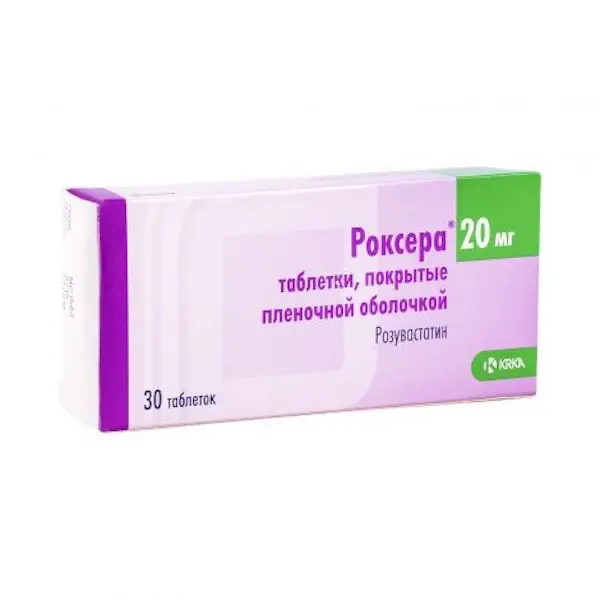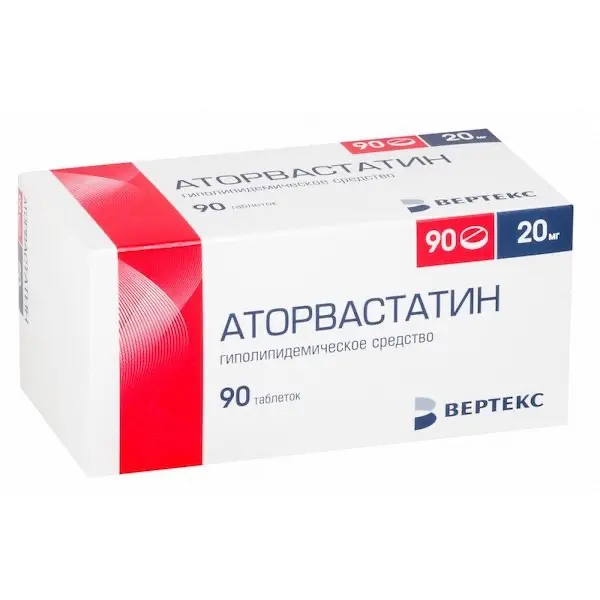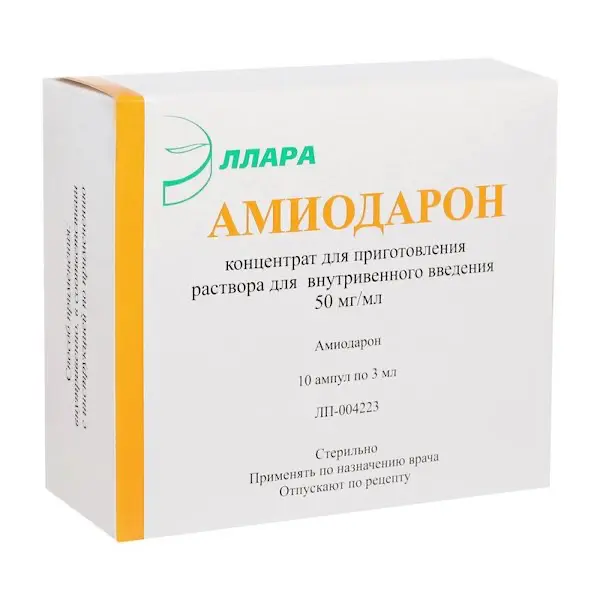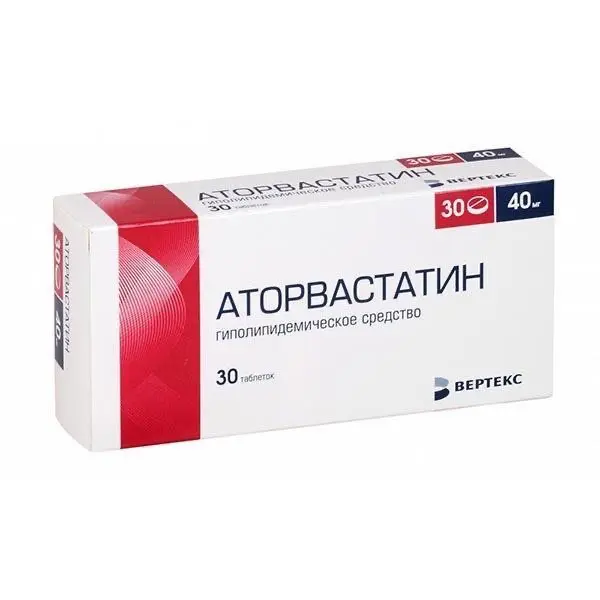Description
Roxera Pharmacodynamics
Mechanism of action
Rosuvastatin is a selective, competitive inhibitor of 3-hydroxy-3-methylglutaryl coenzyme A (HMG-CoA) reductase, an enzyme that converts HMG-CoA to mevalonic acid, a precursor of cholesterol (CH). The main target of rosuvastatin action is the liver, where the synthesis of cholesterol and catabolism of low-density lipoproteins (LDL) take place.
Rosuvastatin increases the number of “hepatic” receptors for LDL on the surface of liver cells, increasing capture and catabolism of LDL, which in turn leads to inhibition of synthesis of very low density lipoproteins (VLDL), thereby reducing the total amount of LDL and LDL.
Rosuvastatin reduces elevated serum concentrations of low-density lipoprotein cholesterol (LDL-C), total CH, triglycerides (TG), increases serum concentrations of high-density lipoprotein cholesterol (HDL-C), and decreases serum concentrations of apolipoprotein B (Apo B), non-HDL-C, very low-density lipoprotein cholesterol (VLDL-C), TG- VLDL, and increases apolipoprotein A-I (Apo A-I) concentrations (see Tables 1 and 2), decreases the ratio of LDL-C/HC-LDL, total CH/LC-LDL and non-LDL-C/HC-LDL and Apo B/Apo A-I ratio.
The therapeutic effect develops within one week after the start of therapy with rosuvastatin, after 2 weeks of treatment it reaches 90% of the maximum possible effect. The maximum therapeutic effect is usually achieved by the 4th week of therapy and is maintained with regular administration of the drug.
Indications
– Primary hypercholesterolemia according to Fredrickson classification (type IIa, including familial heterozygous hypercholesterolemia) or mixed hypercholesterolemia (type IIb) – as dietary supplement when diet and other non-drug treatments (e.g. exercise, weight reduction) are not sufficient.
– Familial homozygous hypercholesterolemia – as an adjunct to diet and other lipid-lowering therapy (e.g., LDL-apheresis) or in cases where such therapy is not sufficiently effective.
– Hypertriglyceridemia (type IV according to Fredrickson classification) – as an adjunct to diet.
– To slow the progression of atherosclerosis – as an adjunct to the diet in patients who are indicated for therapy to reduce plasma concentrations of total cholesterol and LDL-C
– Primary prevention of major cardiovascular complications (stroke, myocardial infarction, arterial revascularization) in adult patients without clinical signs of CHD, but with an increased risk of its development (age over 50 years for men and over 60 years for women, increased plasma concentration of C-reactive protein [? 2 mg/L] in the presence of at least one additional risk factor, such as arterial hypertension, low plasma concentration of HDL-C, smoking, family history of early onset of CHD).
Contraindications
At a daily dose up to 30 mg
– Hypersensitivity to rosuvastatin and/or any of the excipients in the drug;
– Liver disease in the active phase (including a persistent increase in “hepatic” transaminase activity and an increase in “hepatic” transaminase activity in serum more than 3 times the upper limit of normal);
– Severe renal insufficiency (CKR less than 30 ml/min);
– myopathy;
– concomitant use of cyclosporine;
– Patients predisposed to the development of myotoxic complications;
– Pregnancy, breastfeeding;
– use in women with preserved reproductive potential who do not use adequate methods of contraception;
– lactose intolerance, lactase deficiency, glucose-galactose malabsorption syndrome;
– Age less than 18 years.
At a daily dose of 30 mg or more.
– Hypersensitivity to rosuvastatin and/or any of the excipients in the preparation;
– Liver disease in the active phase (including a persistent increase in “hepatic” transaminase activity and an increase in “hepatic” transaminase activity in serum more than 3 times the upper limit of normal);
– moderate to severe renal failure (CKR less than 60 ml/min);
– myopathy;
– concomitant use of cyclosporine;
– Patients predisposed to the development of myotoxic complications;
– pregnancy, breastfeeding;
– use in women with preserved reproductive potential who do not use adequate methods of contraception;
– hypothyroidism;
– history of muscle disease (including family history);
– myotoxicity with a history of use of other HMG-CoA reductase inhibitors or fibrates;
– Excessive use of alcohol;
– conditions that may lead to increased plasma concentrations of rosuvastatin;
– concomitant use of fibrates;
– lactose intolerance, lactase deficiency, glucose-galactose malabsorption syndrome;
– Patients of mongoloid race;
– age less than 18 years old.
Dosage and administration
- Orally, the tablet should not be chewed or crushed, swallowed whole with water, can be taken at any time of the day, regardless of meal time.
- Before the start of therapy with Roxera® , the patient should start following a standard hypocholesterolemic diet and continue it during treatment. The drug dose should be adjusted individually depending on the goals of therapy and the therapeutic response to treatment, taking into account the national recommendations for target plasma lipid concentrations.
- The recommended starting dose of Roxera® for patients starting to take the drug or for patients transferred from other HMG-CoA reductase inhibitors should be 5 or 10 mg once daily.
- When concomitant use of the drug with gemfibrozil, fibrates, nicotinic acid in lipid-lowering doses (more than 1 g/day) patients are recommended a starting dose of 5 mg/day.
- When choosing the initial dose, individual plasma concentrations of cholesterol should be guided and the possible risk of cardiovascular complications should be taken into account, as well as the potential risk of adverse reactions (ADRs). If necessary, the dose can be increased after 4 weeks.
- Due to the possible development of NS when using 40 mg/day dose compared to lower doses of the drug, increasing the dose to the maximum 40 mg/day should be considered only in patients with severe hypercholesterolemia and with a high risk of cardiovascular complications (especially in patients with familial hypercholesterolemia), in whom the desired result of therapy was not reached with 20 mg/day dose, and who will be under medical supervision.
- Especially close monitoring of patients receiving the drug at a dose of 40 mg/day is recommended.
- The 40 mg/day dose is not recommended in patients who have not previously consulted a physician. After 2-4 weeks of therapy and/or if the dose of Roxera® is increased, lipid metabolism parameters should be monitored (if necessary, dose adjustment is required).
- Patients with renal insufficiency
- No dose adjustment is required in patients with mild to moderate renal failure. In patients with severe renal failure (CKD less than 30 ml/min), the use of Roxera® is contraindicated.
- The use of Roxera® in dose more than 30 mg/day is contraindicated in patients with moderate to severe renal failure (CKD less than 60 ml/min).
- In patients with moderate renal failure, the recommended initial dose of Roxera® is 5 mg/day.
- Patients with hepatic impairment
- Roxera® is contraindicated in patients with active liver disease.
- Administration in elderly patients
- No dose adjustment is required.
- Ethnic groups
- Increased systemic exposure of rosuvastatin has been observed in patients of mongoloid race. For Mongoloid patients, the recommended starting dose of Roxera® is 5 mg/day, use of Roxera® at a dose of 40 mg/day is contraindicated.
- Genetic polymorphisms
- Carriers of SLCO1B1 (OATP1B1) p.521CC and ABCG2 (BCRP) p.421AA have increased AUC of rosuvastatin compared to carriers of SLCO1B1 p.52ITT and ABCG2 p.421CC genotypes. For carriers of c.521CC or c.421AA genotypes, the recommended maximum dose of Roxera® is 20 mg once daily.
- Patients susceptible to myotoxic complications
- The use of Roxera® in dose 40 mg is contraindicated in patients susceptible to myotoxic complications. If it is necessary to use 10-20 mg/day, the recommended initial dose for this group of patients is 5 mg/day.
- Concomitant therapy
- Rosuvastatin binds to various transport proteins (in particular, to OATP1B1 and BCRP). When concomitant use of Roxera® with drugs (such as cyclosporine, some human immunodeficiency virus (HIV) protease inhibitors, including the combination of ritonavir with atazanavir, lopinavir and/or tipranavir) that increase the plasma concentration of rosuvastatin due to interaction with transport proteins, the risk of myopathy (including rhabdomyolysis) may be increased. Read the instructions for use of the above mentioned drugs before prescribing them simultaneously with Roxera® . In such cases, the possibility of alternative therapy or temporary discontinuation of Roxera® should be evaluated. If it is necessary to use the above drugs, the benefit/risk ratio of concomitant therapy with Roxera® should be evaluated and the possibility of reducing its dose should be considered.





